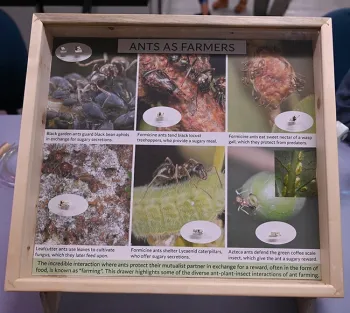Bohart Open House: Fielding Questions About Ants

The three-hour open house included displays of live ants as well as specimens. Ward and newly minted PhDs, Jill Oberski and Zachary Griebenow of the Ward lab, fielded scores of questions. Oberski and Griebenow each wore a "Dr." name tag, presented by Tabatha Yang, Bohart Museum education and outreach coordinator.
"The questions were mostly about the habits and behavior of ants, how many species are there, etc.," Ward related. "And how can I obtain live colonies for my kid? I received almost no queries about 'how do I get rid of them in my kitchen?' and that was refreshing."
"We had live colonies of a centipede-hunting ant (Stigmatomma oregonense) and a generalist omnivore (Aphaenogaster occidentalis)," Ward said. "The displays also included collections of common California ants; the world's smallest ant (Carebara) and the world's largest ant (Myrmecia)."
Griebenow, who recently presented his exit seminar on "Systematic Revision of the Ant Subfamily Leptanillinae (Hymenoptera:Formicidae), Reciprocally Illuminated by Phylogenomics and Morphology," answered questions about his research, and general questions about ant diversity. Griebenow, who holds a bachelor of science degree (2017) in agriculture (entomology), magna cum laude, from The Ohio State University, joined the Ward lab in September 2017.
Oberski, who received her bachelor's degree in biology and a bachelor's degree in German studies (summa cum laude) in 2016 from Macalester College, Saint Paul, Minn., finished her dissertation earlier this month. She will present her exit seminar on "Phylogenetics and Biography of Pyramid Ants" at 4:10 p.m., Wednesday, June 7 in 122 Briggs Hall. It also will be on Zoom.

Questions at the open house? Oberski shared that she received "some great questions about ant diets. What do ants eat? Are ants specialized or generalized in their feeding habits? The answer can vary a lot. Some ants are generalists that eat any food they come across, but others are extremely specific, like ants that are fungus farmers or specialized predators of springtails, spider eggs, or centipedes."
Professor Ward is featured in a Bohart Museum of Entomology video on YouTube at https://youtu.be/d8eRNsD8dxo. Ants, he related, originated about 120 million years ago (early Cretaceous), evolving from "wasp-like creatures." They are members of the order Hymenoptera, and their closest relatives include honey bees, cockroach wasp and the mud daubers. California is home to some 300 species of ants, but thousands more live in the tropics. Globally, there may be as many as 40,000 to 50,000 species of ants, the professor estimated, but only about 14,000 are described.
Also in the video, Ward related that ants live in long-lived colonies with (1) cooperative brood care (2) overlapping generations and (3) reproductive division of labor, the hallmarks of eusocial behavior. He also pointed out:
- A typical ant colony contains a reproductive queen, numerous non-reproductive workers and brood (eggs, larvae, pupae)
- Colonies of ants can be thought of as superorganisms: tightly integrated and cooperative entities with complex systems of communication and division of labor (castes)
The Bohart Museum, directed by UC Davis distinguished professor Lynn Kimsey, houses a global collection of eight million insects and also maintains a live "petting zoo" (Madagascar hissing cockroaches, stick insects, tarantulas and others) and an insect-themed gift shop. The museum is located in Room 1124 of the Academic Surge Building, 455 Crocker Lane.
The next Bohart Museum open house, themed "Insects and Forensics," will be from 1 to 4 p.m., Saturday, June 3. It will feature forensic entomologist Robert "Bob" Kimsey and his work.
